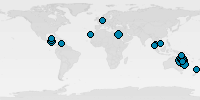
The Steps at Pendennis Point offers diving at 5 German U-Boats that were captured during WWI and survived Allied training practises.
| Name Dive Site: | Steps, Pendennis Point, U-Boats |
| Inserted/Added by: | atlanticscuba |
| Rated: | Rated 3.7, 3 votes |
| Specifications: |  |
Send us your images for this dive site[Add Image][Add Movie]
At the end of WWI the captured German navy was all scuttled at Scapa Flow, Orkney. A lot of the fleet was re-floated and fleet was dispersed between the Allied Forces. The Royal Navy had a surplus of ships and had no need for the war battered remnants of the German fleet. A lot were to be used as target practice but 5 of the German U-Boats escaped being shot at one last time. As they were moored up in Falmouth Bay awaiting their time, a storm brewed up. They broke their moorings and blew up onto the rocks at Pendennis Point. A few years later they were heavily salvaged, but some large parts do remain.
Pendennis Point separates Falmouth harbour from the sea. The Steps as it is commonly called, is the training ground for most of the local dive schools, including Truro College, making it the second most popular shore dive after Porthkerris. At a maximum depth of 10m on the highest spring tide it is ideal for training, or for testing out new kit. With enough life and metal to keep most divers interested, if you swim far enough offshore you'll even find the odd scallop. At low tide there isn't a lot of water. In fact, on a low spring tide part of one of the submarines breaks the surface.
Driving around the one way system on Pendennis point, the first landmark on the left is the dockyard, then a little further on there is a car park. A few hundred metres more just before the road becomes two way, there is a layby on the left. Park there, it's free. A photo of the layby is below. The path to the steps is just to the left of the layby. The path splits into two. It is possible to enter the water from the left hand path and steps, but it is far easier and much more sensible to enter from the well trodden right hand path and steps. There are quite a few steps down, but for most of the way there is a heavy duty handrail, especially useful on the way back up. Everyone leans against the wall to put their fins on, then in you go.
The reef shelves slowly down to the sand; the best diving and the biggest piece of wreckage is heading south easterly back towards the point. Every year there seems to be more and more kelp – it can make navigation a little tricky. Following the reef there is a series of sandy bottomed gullies. It is within these gullies some of the U-boat remains can be found. The largest piece is found in a gully just a 100m straight out from the second set of steps.
The shallowest part is about 4m deep, and that's on the biggest spring tide. Usually covered in kelp it can be hard to spot the rest of the wreck, but there is a large part of the bottom of the hull. Some is covered in sand and there are odd spars sticking out.
A little further north east there is another gully, this time with fairly sheer sides. It winds its way along until it reaches a small cave at the end. There are the remains of an old motorbike inside the cave; the sand covers and uncovers it at different times. It is near the stone wall which can easily be spotted from the surface. Wrasse are prevalent all over the site as are pollack. Dogfish can sometimes be found lying at the bottom of the gullies or on the sand, so can common pipefish. Lobsters sit in the odd crack in the rocks, if you can be bothered to fight your way through the kelp that is. Starfish, snakelock anemones and the odd crab can be spotted under the kelp too.
Wreckage can be found anywhere – there were 5 U-boats after all. I have seen hatches and all different shapes and sizes of scrap metal. I have been told there are two boilers out on the sand from an old fishing boat but I've never found them. You can venture out beyond the course sandy bottom onto a stone covered area where you can find the odd scallop or two.
Visit our partners! Or become one.
Diveshop
- Atlantic Scuba, 4 Trenoweth Business Park, Mabe, Falmouth
Atlantic Scuba
| Atlantic Scuba diver training ... www.atlanticscuba.co.uk/ 07866 510103 01841 510103 | 4 Trenoweth Business Park, Mab... TR10 9HY Falmouth |
Based on the outskirts of Falmouth @ Mabe we are away from the busy town centre. With plenty of parking and good roads to our usually training sites and boat location at Mylor. We teach a wide range of SDI courses and operate a coded dive rhib.
With around 20 SDI & TDI courses we can offer you a wide opportunity to expand your diving skills. We also offer escorted dives with kit hire if required, a retail shop, cylinder testing and a dive pool. Our twin engined catarmaran RHIB is coded for 10 divers and is more than capable of taking you to a dive site that's suits your requirements.
[Add Message]Messages from readers:
[Add Divelog]Divelogs from members:
